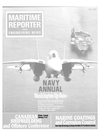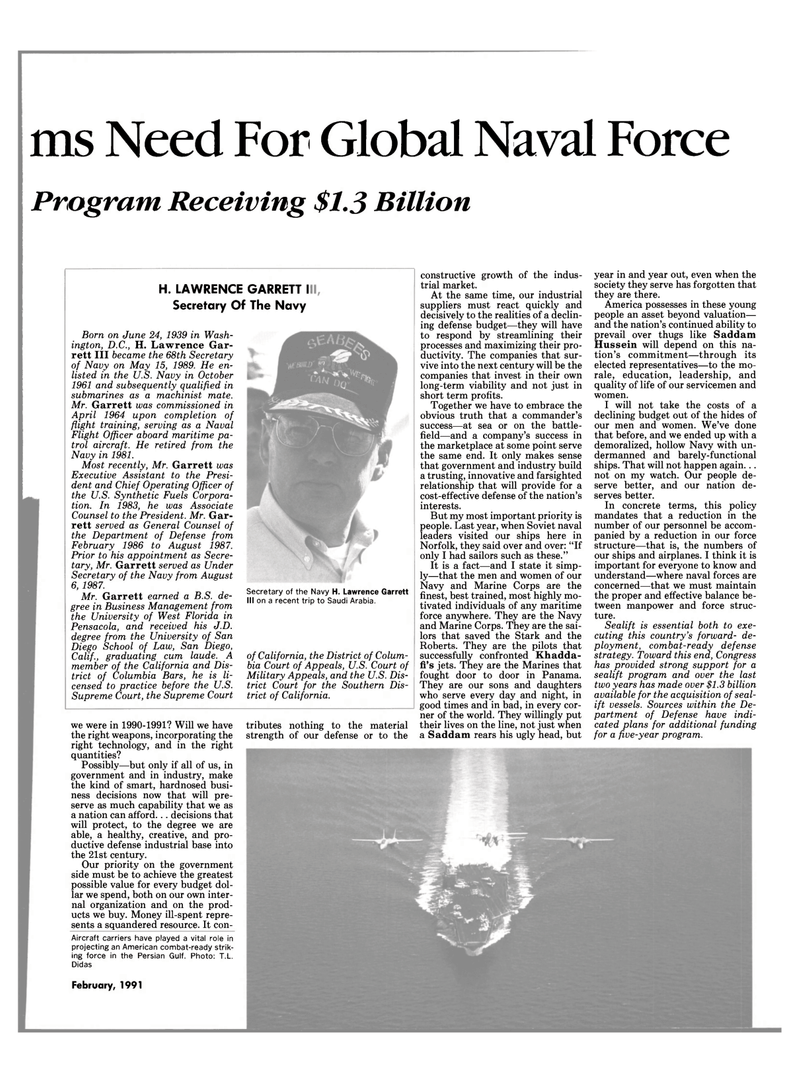
Page 39: of Maritime Reporter Magazine (February 1991)
Read this page in Pdf, Flash or Html5 edition of February 1991 Maritime Reporter Magazine
ms Need For Global Naval Force
Program Receiving $1.3 Billion
H. LAWRENCE GARRETT I
Secretary Of The Navy
Born on June 24, 1939 in Wash- ington, D.C., H. Lawrence Gar- rett III became the 68th Secretary of Navy on May 15, 1989. He en- listed in the U.S. Navy in October 1961 and subsequently qualified in submarines as a machinist mate.
Mr. Garrett was commissioned in
April 1964 upon completion of flight training, serving as a Naval
Flight Officer aboard maritime pa- trol aircraft. He retired from the
Navy in 1981.
Most recently, Mr. Garrett was
Executive Assistant to the Presi- dent and Chief Operating Officer of the U.S. Synthetic Fuels Corpora- tion. In 1983, he was Associate
Counsel to the President. Mr. Gar- rett served as General Counsel of the Department of Defense from
February 1986 to August 1987.
Prior to his appointment as Secre- tary, Mr. Garrett served as Under
Secretary of the Navy from August 6, 1987.
Mr. Garrett earned a B.S. de- gree in Business Management from the University of West Florida in
Pensacola, and received his J.D. degree from the University of San
Diego School of Law, San Diego,
Calif., graduating cum laude. A member of the California and Dis- trict of Columbia Bars, he is li- censed to practice before the U.S.
Supreme Court, the Supreme Court
Secretary of the Navy H. Lawrence Garrett
III on a recent trip to Saudi Arabia. of California, the District of Colum- bia Court of Appeals, U.S. Court of
Military Appeals, and the U.S. Dis- trict Court for the Southern Dis- trict of California. we were in 1990-1991? Will we have the right weapons, incorporating the right technology, and in the right quantities?
Possibly—but only if all of us, in government and in industry, make the kind of smart, hardnosed busi- ness decisions now that will pre- serve as much capability that we as a nation can afford... decisions that will protect, to the degree we are able, a healthy, creative, and pro- ductive defense industrial base into the 21st century.
Our priority on the government side must be to achieve the greatest possible value for every budget dol- lar we spend, both on our own inter- nal organization and on the prod- ucts we buy. Money ill-spent repre- sents a squandered resource. It con-
Aircraft carriers have played a vital role in projecting an American combat-ready strik- ing force in the Persian Gulf. Photo: T.L.
Didas
February, 1991 41 tributes nothing to the material strength of our defense or to the constructive growth of the indus- trial market.
At the same time, our industrial suppliers must react quickly and decisively to the realities of a declin- ing defense budget—they will have to respond by streamlining their processes and maximizing their pro- ductivity. The companies that sur- vive into the next century will be the companies that invest in their own long-term viability and not just in short term profits.
Together we have to embrace the obvious truth that a commander's success—at sea or on the battle- field—and a company's success in the marketplace at some point serve the same end. It only makes sense that government and industry build a trusting, innovative and farsighted relationship that will provide for a cost-effective defense of the nation's interests.
But my most important priority is people. Last year, when Soviet naval leaders visited our ships here in
Norfolk, they said over and over: "If only I had sailors such as these."
It is a fact—and I state it simp- ly—that the men and women of our
Navy and Marine Corps are the finest, best trained, most highly mo- tivated individuals of any maritime force anywhere. They are the Navy and Marine Corps. They are the sai- lors that saved the Stark and the
Roberts. They are the pilots that successfully confronted Khadda- fi's jets. They are the Marines that fought door to door in Panama.
They are our sons and daughters who serve every day and night, in good times and in bad, in every cor- ner of the world. They willingly put their lives on the line, not just when a Saddam rears his ugly head, but year in and year out, even when the society they serve has forgotten that they are there.
America possesses in these young people an asset beyond valuation— and the nation's continued ability to prevail over thugs like Saddam
Hussein will depend on this na- tion's commitment—through its elected representatives—to the mo- rale, education, leadership, and quality of life of our servicemen and women.
I will not take the costs of a declining budget out of the hides of our men and women. We've done that before, and we ended up with a demoralized, hollow Navy with un- dermanned and barely-functional ships. That will not happen again... not on my watch. Our people de- serve better, and our nation de- serves better.
In concrete terms, this policy mandates that a reduction in the number of our personnel be accom- panied by a reduction in our force structure—that is, the numbers of our ships and airplanes. I think it is important for everyone to know and understand—where naval forces are concerned—that we must maintain the proper and effective balance be- tween manpower and force struc- ture.
Sealift is essential both to exe- cuting this country's forward- de- ployment, combat-ready defense strategy. Toward this end, Congress has provided strong support for a sealift program and over the last two years has made over $1.3 billion available for the acquisition of seal- ift vessels. Sources within the De- partment of Defense have indi- cated plans for additional funding for a five-year program.

 38
38

 40
40
